First Impression: 2023 Nissan Ariya
After a series of delays, Nissan’s second all-electric model, the 2023 Ariya, is finally in production and ready to start rolling into U.S. showrooms. And it couldn’t come at a more critical time.
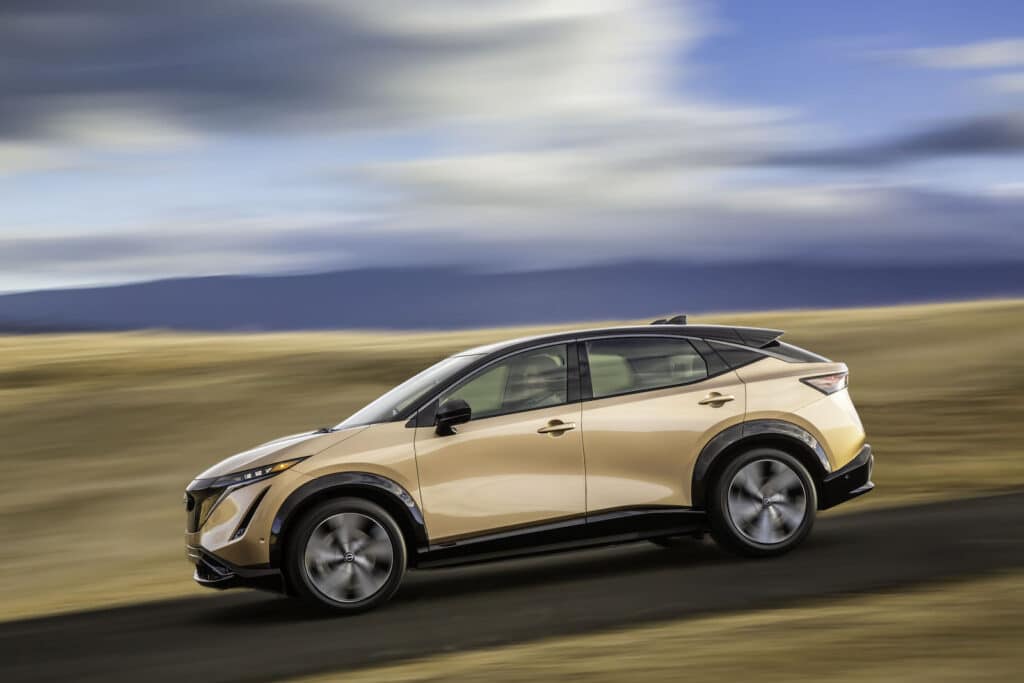
The original Nissan EV, the Leaf, was a pioneering product, the first mass-market battery-electric vehicle. But the EV space is getting flooded with alternatives, from Tesla products like the Models 3 and Y to the big Ford F-150 Lightning. And the latest models, on the whole, offer more features, improved range and notably better performance than even the second-generation Leaf.
For its part, the Ariya adopts a more popular crossover-style body, delivers more power and substantially better range — though it will cost a fair bit more than the Leaf, one of the market’s most affordable battery-electric vehicles.
TheDetroitBureau.com had a chance to get into the new Ariya on a beautiful fall day, taking it for a winding run through Southeast Michigan that offered a chance not only to check out the battery drive system but the latest — and, now, hands-free version of Nissan’s ProPilot 2.0 system.
Styling
Pronounced like the song an opera diva sings, a concept version of the Ariya made its first appearance at the 2019 Tokyo Motor Show. Though there were some design details unique to exotic concepts, like the oversized wheels, but the show car has gone into production with surprisingly few changes.
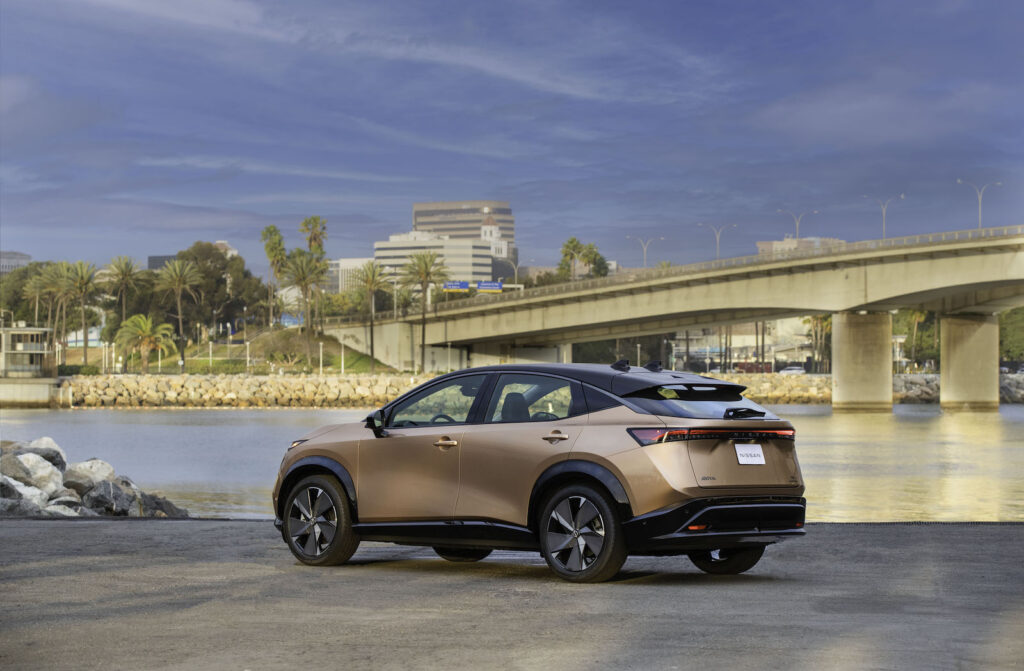
The design of the 2023 Nissan Ariya is what the automaker has dubbed “Japanese futurism.” It has a distinctly Asian feel with plenty of high-tech details, such as the multi-LED headlamp system.
As with most of today’s battery-electric vehicles, the original concept spent a lot of time in the wind tunnel — good aerodynamics translating into improved range and performance. A close inspection reveals a number of details meant to cheat the wind, starting with the sealed panel replacing a conventional grille, the turbine blade-like wheels and the aggressively curved roofline that wraps up with a built-in spoiler.
The 2023 Ariya is roughly the same size as Nissan’s conventionally powered Rogue SUV, but the EV features a 2.8-inch longer wheelbase, stands an inch taller and is about 2 inches wider. Since its batteries and motors are mounted below the load floor, space normally devoted to an engine compartment has been repurposed for passengers and cargo. That translates into a class-above cabin that’s as roomy as the Nissan Murano.
The interior also boasts a flat load floor with a floating center console that can slide forward or back. The overall look is much more high-tech than existing Nissan crossovers. A major reason is the use of twin 12.3-inch displays: a reconfigurable gauge cluster and a touchscreen infotainment display. Our Premier package test vehicle also boasted a 10-inch head-up display.
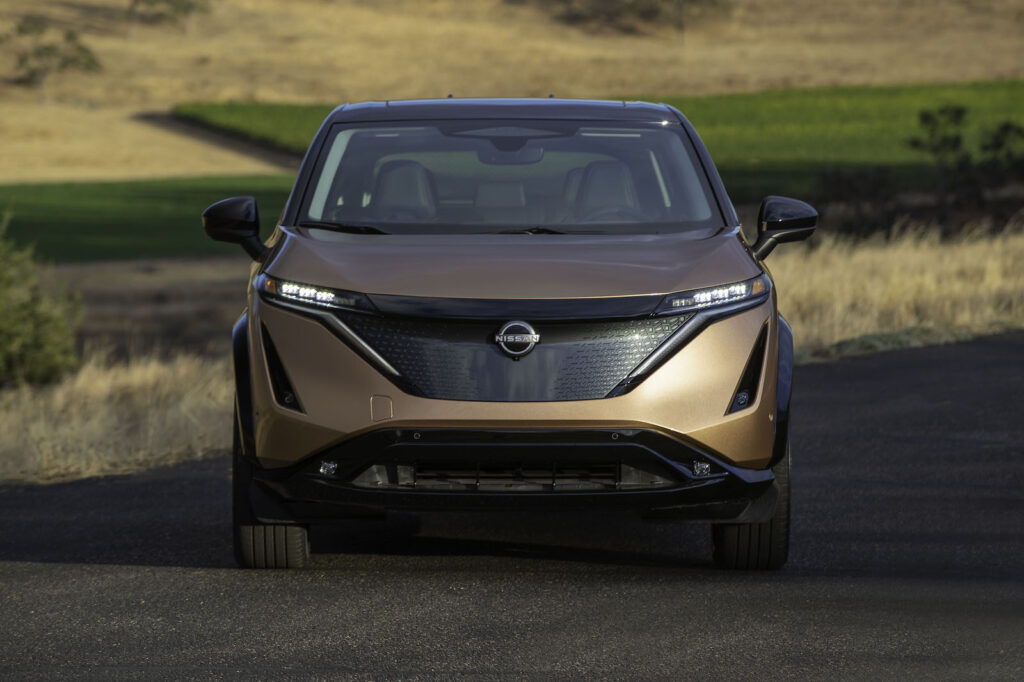
Like other new EVs, the Ariya makes good use of ambient lighting, including a bar across the top of the instrument panel that can signal various functions — such as when the ProPilot 2.0 system is operating. A more unusual feature is the “Kumiko Lantern” on the firewall below the instrument panel.
Performance
Nissan offers buyers a variety of different configurations with the 2023 Ariya. There are the usual upgrades adding more desirable features. But buyers can also choose between front- or all-wheel drive, as well as standard- and long-range battery packs.
The base Engage model features a single motor mounted on the front axle making 214 horsepower and 221 pound-feet of torque. It draws power from a 63 kilowatt-hour lithium-ion battery delivering an EPA-estimated range of 216 miles per charge.
Step up to the Venture+ package, with its single motor and an 87 kWh battery pack to get a modest boost in performance at 238 hp — though torque remains 221 lb-ft. This is the Ariya range champ at an estimated 304 miles per charge.
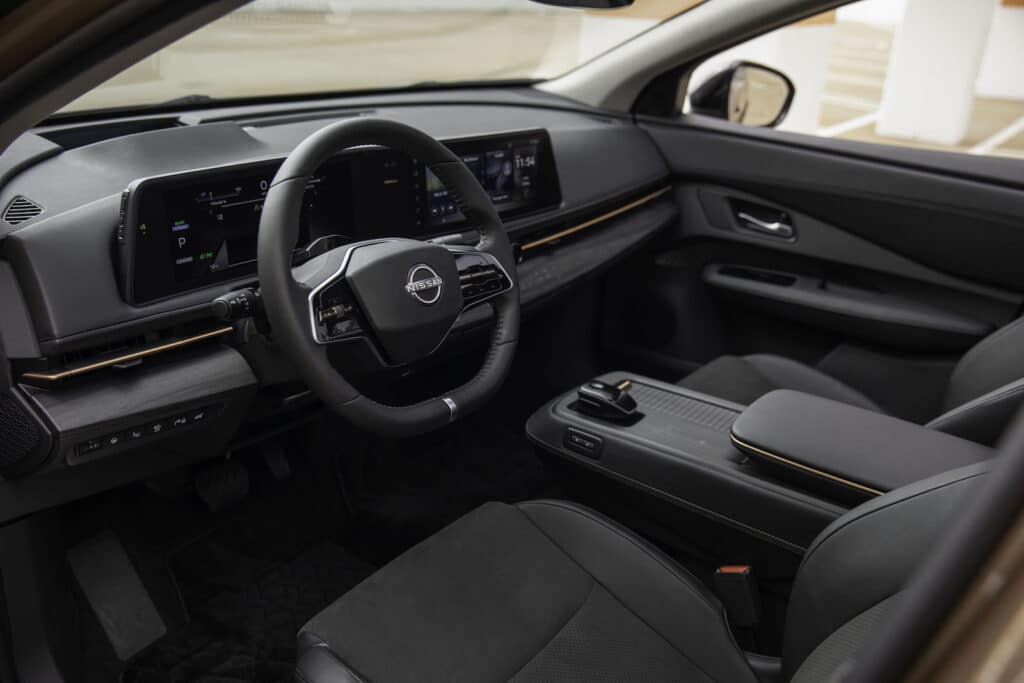
For those seeking the maximum amount of performance and features, there’s the 2023 Nissan Ariya Platinum+ e-4orce. It’s a twin-motor “smart” all-wheel-drive package that makes a more substantial 389 hp and 442 lb-ft of torque. Twin-motor packages deliver anywhere from 205 to a maximum 270 miles range, depending upon the size of the battery pack and other features.
The smaller battery pack requires 10.5 hours to go from a 0% to 100% charge using a home Level 2 system. Plug into a public quick charger and you’ll go from a 20% to 80% state-of-charge in as little as 35 minutes. With the larger pack, home charging will take up to 14 hours, with a quick charge from 20%-80% estimated at 40 minutes.
Technology
The 2023 Nissan Ariya is loaded with an array of high-tech features, from adjustable ambient lighting to the automaker’s latest semi-autonomous technology, ProPilot 2.0.
That hands-free system marks a big improvement from the previous version of ProPilot from my experience, more smoothly maintaining its position in your lane where it requires you to keep your hands on the wheel. But it now allows a motorist to go hands-free on up to 200,000 miles of limited-access highways, according to Nissan. (It uses the same high-resolution mapping system as General Motors’ Super Cruise.) I got to try it out in hands-free mode for about 10 miles and was reasonably impressed with its ability to smoothly handle curves and surrounding traffic.
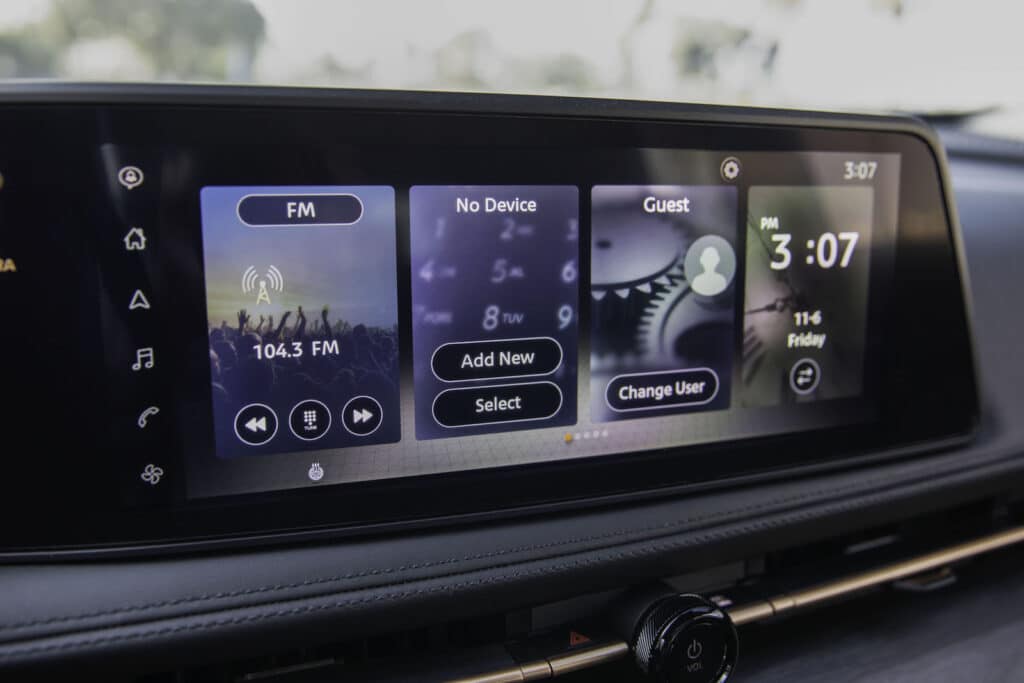
My test vehicle also included a hands-free parking system which proved to be a bit more herky-jerky but, nonetheless, quite capable of sliding the electric crossover into tight spots I myself might have driven past.
Ariya also offers an assortment of advanced safety systems, including automatic emergency braking with pedestrian detection and lane departure warning.
The twin displays are easy to read and the infotainment system is reasonably simple to program. And it can operate either Apple CarPlay or Android Auto. Oddly, the Apple technology can be used wirelessly. With Android, however, you need a USB cable.
Initial Impression
I had the chance to drive the twin motor Premier version of the 2023 Nissan Ariya and was, on the whole, reasonably impressed.
The crossover is delightfully quiet, a key selling point for Nissan. Too quiet, some folks might think. For those who like a little aural feedback as they accelerate simply switch to Sport Mode which kicks in a subtle audio soundtrack that mirrors what your foot is doing on the throttle.
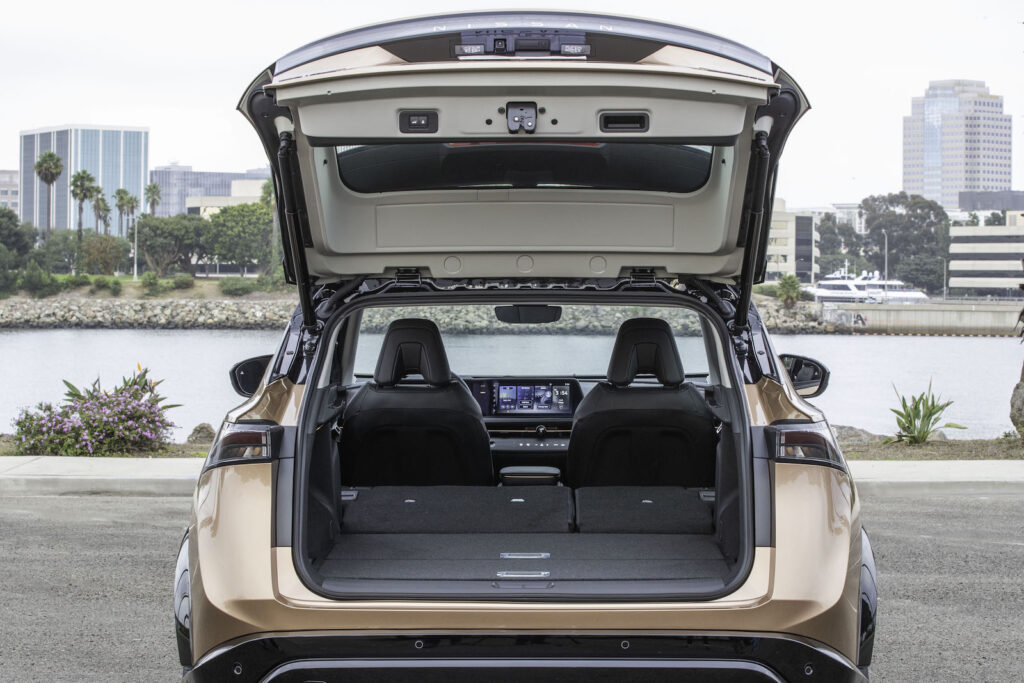
When it comes to performance, I’d have liked a bit more muscular feel to the Premier package. It reminded me of the tame Toyota bZ4X, rather than the sporty Hyundai Ioniq 5, to name two key competitors. I’m hoping to get some seat time with the Platinum+ e-4orce to see if that kicks up some ya-yas.
One disappointment I hope Nissan will quickly address is the lack of a 1-Pedal driving function. Like all EVs, the Ariya uses brake regeneration to recapture energy lost during braking and coasting, sending it back to the battery to extend range. You can adjust the level of “brake regen” but, unlike the similarly sized Ioniq 5 and Kia’s EV6, you can’t go to a maximum level. 1-Pedal feels, essentially like downshifting a gas powertrain three or four gears, allowing you to slow, even stop, simply by modulating the throttle.
On vehicles with 1-Pedal, I seldom ever take my foot off the throttle while driving. And I’d personally not buy a vehicle without that feature. The good news is that Ariya is capable of over-the-air updates and could add 1-Pedal functionality if the automaker senses customer demand. OTA will allow it to tweak existing software and add other new features, as well.
Overall, the Ariya is a pleasant, comfortable and easy car to drive. It’s a big step beyond the old Leaf and stands up well against key competitors. It’s nice to see Nissan finally get serious about EVs again.
The 2023 Nissan Ariya starts at $43,190 for the base model with a single motor and standard battery pack. With all-wheel-drive and the extended pack, a top-line Ariya Platinum package pushes up to $60,190.
2023 Nissan Ariya – Frequently Asked Questions
Will the 2023 Nissan Ariya qualify for the $7,500 EV incentives?
The Nissan Ariya won’t qualify for incentives as it is assembled in Japan. Vehicles now need to be made in North America and use locally sourced batteries and battery raw materials like lithium, cobalt and nickel.
How big is the 2023 Nissan Ariya?
From an exterior footprint it’s roughly the same size as the gas-powered Nissan Rogue. But, it has a cabin closer in size to the Murano because some of the space normally devoted to the engine compartment was repurposed for passengers and cargo.
Will the Nissan Ariya replace the Leaf?
While it’s unclear how much longer the original Nissan battery-electric vehicle will remain in production, the automaker plans to continue marketing the Leaf as well as the larger, more crossover-styled Ariya.
Auto Lovers Land
Comments
Post a Comment